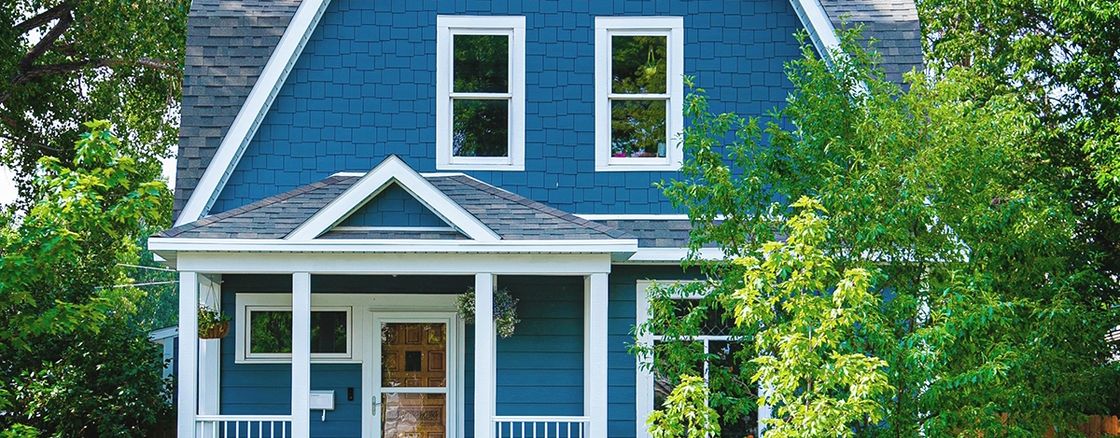A Breakdown: 5 Different Types of Mortgages
Written by:
Lauren Hargrave
Lauren Hargrave
Personal Finance Writer
Lauren Hargrave is a writer from San Diego who focuses on technology, finance, and healthcare. She worked in finance for seven years before pivoting to a career in writing, and now, instead of putting numbers into spreadsheets, she writes about them instead.
See full bio
Fact Checked by:
Mike Tassone
Mike is a Co-Founder and Chief Operating Officer of Own Up. He has expertise in all areas of residential lending, having led operations for a top 40 lender in the United States.
See full bio

When you’re buying a house, the sheer number of financing options can feel overwhelming. First, there might be unfamiliar terminology. Second, how do you compare the different mortgage types and rates to one another? Third, how do you know which type of loan is best for your specific situation?
In this post, we’ll walk you through the different mortgage types, their unique features, the types of loan situations for which they may be appropriate, and how to qualify. Just keep in mind that this is a general overview and that individual lenders and loans may have additional features and qualifying criteria.
Important Mortgage Loan Terminology
Before we talk about the types of mortgage loans, we want to introduce some relevant terms that will help you understand how different loans function.
Loan Amount
This is the total amount you’re borrowing.
Loan Term
This is the length of time you have to pay off the loan. If it’s a 30-year fixed-rate mortgage, your debt payments will be spread out over 30 years. Typically, the longer the loan term, the lower your monthly debt payments will be. However, the overall cost of the loan may be higher since you’re paying interest over a longer period of time.
Debt-to-Income Ratio
The debt-to-income ratio is your monthly debt payments divided by your total monthly income.
Interest rate
This is how much it costs you to borrow money. The interest rate a lender charges will often depend on the type of loan, your credit score, the national interest rate environment, and more.
Monthly Payment
This is the total amount you will pay to the lender each month. It will include payment of your principal balance, interest charges, and (depending on how you set up your mortgage) it may include other charges like property taxes and homeowners insurance.
Credit score
Your credit score is a numerical representation of how likely you are to repay your debt. Many factors can affect your credit score, including whether you’ve made on time or late payments, the length of your credit history, and more.
Down payment
Your down payment is the amount of cash you use to buy a house. So if the house costs $500,000 and you have $100,000 in cash, and then borrow $400,000 in order to purchase the house, you have put down a 20% down payment.
If you put down less than 20%, a lender will likely require you to purchase private mortgage insurance (PMI), which will be included in the monthly cost of your mortgage. Once your loan balance reaches 80% of the appraised value of the home, your lender could drop the PMI requirement.
Private Mortgage Insurance
Mortgage insurance protects the lender if you stop making your debt payments. Different mortgage types will have different mortgage insurance requirements, depending on how large of a down payment you’re able to make. If your lender does require mortgage insurance for your loan, it will most commonly be included in your monthly payment.
As stated above, once you reach 20% equity in your home, your lender could drop its PMI requirement. But this will depend on the type of mortgage you have and your lender’s policies. Make sure to ask your lender about their PMI policies prior to closing on your loan.
Conforming loans
These are loans that meet the underwriting guidelines of Fannie Mae and Freddie Mac and have a total loan amount that is either at or below the limit the Federal Housing Finance Agency (FHFA) has set for your geographic area. Lenders tend to like conforming loans because they can sell these loans to the Fannie Mae or Freddie Mac agencies.
2023 Standards for Conforming Loans
- The loan amount is $726,200 or less.
- A loan amount of up to $1,089,300 in high-cost counties. The maximum loan amount for conforming loans in high-cost counties will depend on the county in which the home is located.
- Borrowers have a credit score of at least 620.
- The debt-to-income ratio for the loan is 45% or less.
- Down payments can be as low as 3% for qualified borrowers.
Nonconforming loans
These types of loans don’t meet the above standards. That means they could have a higher loan amount, and/or lower credit score or debt-to-income ratio requirements.
Types of Loans
There are a handful of loan types that you may encounter during your mortgage research and application process. Let’s break them down.
Mortgage Type #1: Conventional Loans
Conventional mortgages are the most common types of home loans. Here is a list of seven distinguishing features they have:
- They aren’t part of a specific government program.
- They’re offered by a range of private lenders including banks, credit unions, or mortgage companies.
- They can have a fixed interest rate (i.e. they are a fixed-rate loan) or a variable interest rate (i.e. they are an adjustable rate mortgage or ARM). More on this later.
- They can be categorized as jumbo mortgages if their loan amount exceeds the annual limit set by Fannie Mae and Freddie Mac. (For 2023, that limit is $726,200.)
- If your down payment is less than 20% of the purchase price, you will likely need to get private mortgage insurance. Once your loan balance reaches 80% of your home’s value, you can typically get rid of your private mortgage insurance.
- They can be categorized as “conforming” if they meet the Fannie Mae or Freddie Mac requirements.
- They can be categorized as “nonconforming” if they don’t meet the standards set by Fannie Mae and Freddie Mac. Nonconforming conventional loans can vary widely in terms of eligibility requirements, interest rates, and other features.
Nonconforming conventional loans can be a good option for:
- Borrowers that have a poor credit score
- Affluent borrowers that are self-employed or have another source of nontraditional income
- People buying property that have unusual features like large acreage or agricultural income.
The Consumer Financial Protection Bureau recommends that if you’re considering a nonconforming loan, that you consult with multiple lenders and ask if you qualify for an FHA loan instead.
Mortgage Type #2: Government-Backed Mortgages
Government-backed loans are home mortgages that are insured by government agencies. These types of mortgages are less risky than conventional loans for lenders because the government pays for the loan if the borrower defaults. These loans can have more lenient credit score requirements and down payment requirements, but they also can come with higher interest rates and include other fees.
Types of government-backed loans include:
FHA Loans
These mortgages are insured by the Federal Housing Administration (FHA) and require a credit score of 580 and a down payment of at least 3.5%. Borrowers that can pay a down payment of at least 10% of the purchase price can qualify with a credit score of 500. If borrowers put down less than 10% of the purchase price, loan terms will require them to pay for private mortgage insurance for the entire loan term. If you put down 10% or more, your private mortgage insurance can be removed after 11 years.
VA Loan
These mortgages are insured by the Department of Veteran Affairs (VA) and are available to people who have served in the U.S. military and meet the department’s active duty requirements. These loans don’t require private mortgage insurance and instead charge a funding fee of 2.15% of the loan amount. Veterans can choose to pay the funding fee in cash or roll it into the loan amount. Certain circumstances, such as a service-related disability, may also impact the amount of the fee or whether the borrower needs to pay it at all.
USDA Loans
This type of government-backed loan is insured by the U.S. Department of Agriculture (USDA) and is available for properties in rural areas. These loans have no private mortgage insurance or down payment requirements, but they do have income requirements. Borrowers of USDA loans are required to pay a one-time fee of 1% of the loan amount and an annual fee of 0.35% of the loan balance.
Mortgage Type #3: Fixed-Rate Mortgages
Fixed-rate mortgages are simply home loans that maintain the same interest rate over the entire term of the loan. This offers the borrower a consistent and predictable monthly payment, and can make it easier to compare mortgages because the cost of the loan is known.
Conforming, nonconforming, conventional, and government-backed loans can all be fixed-rate mortgages as long as the interest rate stays constant.
Mortgage Type #4: Adjustable-Rate Mortgages (ARMs)
Adjustable-rate mortgages (also known as variable-rate mortgages) have an initial interest rate that stays constant for a set period of time (usually the first few years of the loan term) but can change afterward, depending on market conditions. There are three types of ARMs:
- Interest-only ARMs (also known as balloon mortgages)
- Hybrid ARMs
- ARMs with a payment option
Interest-Only ARMS
Interest-only ARMs require that borrowers only pay the interest charge on the mortgage for a specified period of time. At the end of the interest-only period, the borrower’s mortgage payment will include both interest and principal.
While interest-only ARMs usually result in lower upfront monthly payments, they also produce what’s called a balloon payment at the end of the loan term (since there was a period of time when the borrower wasn’t paying down the principal balance of the loan). A balloon payment is defined as a payment that is larger than the typical monthly payment on a mortgage (and is often tens of thousands of dollars). These types of mortgages were more common prior to the home mortgage crisis in 2008, but are still available through some lenders today.
Hybrid ARMS
Hybrid ARMs are structured with a combination of fixed- and adjustable -rate periods during the loan term. Typically, the rate is fixed in the beginning of the loan term, then begins to “float,” i.e. adjust, after the fixed period is over.
Payment Option ARM
A payment option ARM gives borrowers several payment options: principal and interest, interest only, or a minimum payment option that might not cover the total interest payment. This type of ARM can also result in a balloon payment at the end of the loan term if the borrower doesn’t choose the principal and interest payment option every month.
Mortgage Type #5: Jumbo Loans
A loan is categorized as “jumbo” if it has a loan amount that exceeds the limit Fannie Mae and Freddie Mac have set for that year. For 2023, any mortgage that exceeds $726,200 is considered a jumbo loan. A jumbo loan can still be a “conforming” loan as long as the property is located in a high-cost county and the loan amount is at or below what Fannie Mae and Freddie Mac have determined is the conforming limit for that county.
The Niche Loan: The Reverse Mortgage
Reverse mortgages provide a way for people who have built considerable equity in their homes by either paying down most or all of their mortgage, or by a considerable increase in the value of their house. With a reverse mortgage, the borrower accrues interest on the loan amount for the entire loan term, but doesn’t pay back any principal or interest until they sell the property.
These types of loans are often advertised to retirees as they have often lived in their homes for a long period of time and either paid down their mortgage considerably or completely. They can provide needed cash flow to seniors but are also risky since home equity is often the primary source of savings for the elderly. Once seniors sell their house, this savings could be wiped out by the reverse mortgage balance.
How to Compare Your Mortgage Options
One of the easiest ways to compare your mortgage options is to use the loan estimates you receive for each loan. A loan estimate is a three-page form you receive after applying for a mortgage that gives you important details about the loan you’ve requested. Lenders are required to give you a loan estimate within three days of receiving your loan application and all lenders are required to use the same form. The form should include the following information:
- Estimated interest rate
- Monthly payment
- Closing costs for the loan
- Estimated costs for taxes and insurance
- How the interest rate and monthly payments might change in the future
- Any special features of the loan like prepayment penalties
Using the loan estimate forms, you can compare the total costs of the loans and decide if any of the special features are incompatible with your future plans (for example, there’s a large prepayment penalty and you’re planning to sell the house in three years). If you’re trying to determine whether or not a lender is offering you a “good” interest rate, it’s important to understand that many factors affect interest rates. Let’s talk about three of them:
- One factor is your strength as a borrower (i.e. your credit score, income, etc.).
- The second factor is the mortgage type for which you’re applying.
- The third factor is the national interest rate environment. According to the Consumer Finance Protection Bureau, interest rates are at the highest point they’ve been in years. It can be very difficult to predict which direction interest rates are going to go since they’re influenced by a multitude of economic forces that are often beyond our control.
The Bottom Line
The best way to make sure you get the best mortgage for you is to make sure you have applied for the right type of mortgage, compare the loan estimates you receive from the lenders, and then make sure the total cost of the loan fits within your budget and the special features are compatible with your future plans.


